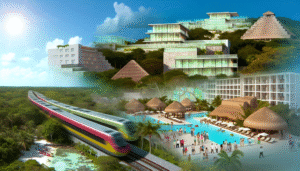Tulum International Airport: Innovation and Sustainability in the Mexican Caribbean
Since December 1, 2023, Tulum International Airport “Felipe Carrillo Puerto” has become a milestone for mobility in the region. Strategically located just 20 kilometers southwest of Tulum, this airport is not only a gateway to the natural beauty of Quintana Roo but also represents a significant advancement in terms of sustainability and architectural design. In this article, we will explore the airport’s innovative features, its development, and the positive impact it will have on the local economy and tourism.
A Green and Modern Airport
As Mexico’s first green airport, Tulum International Airport stands out for its commitment to the environment. The airport’s design includes an impressive glass dome that is not only aesthetically attractive but also helps streamline the venue’s energy consumption. With a waiting room offering panoramic views and rest areas with loungers, travelers will enjoy a unique experience from the outset.
Cutting-edge Infrastructure
The airport features a 3,700-meter runway, allowing it to accommodate a variety of aircraft, from commercial jets to cargo planes. With 13 positions designated for commercial aircraft and an exclusive platform for executive aviation with 28 spaces, the airport is prepared to meet the growing demand for air transport in the region. Additionally, its 45-meter control tower and operations center integrating advanced technology ensure that air navigation is efficient and safe.
Impact on the Local Economy
The construction of Tulum International Airport not only meets mobility needs but also focuses on regional economic development. The facility is expected to act as a catalyst for the growth of a commercial corridor and the creation of an airport city. This will spur orderly urban development along nearby roads, creating new employment and business opportunities.
Connectivity and Access
One of the most important features of Tulum International Airport is its connection with the Mayan Train. This railway station is part of one of the most ambitious infrastructure projects in southern Mexico, facilitating access to different regions of the peninsula. This type of interconnection will transport not only passengers but also goods and services, further stimulating the local economy.
Commitment to Sustainability
Tulum International Airport has also implemented ecological measures such as water treatment plants and solid waste recycling systems, reaffirming its commitment to environmental protection. By developing infrastructures that respect and care for nature, the airport sets a model for future projects in Mexico.
Conclusions
Tulum International Airport “Felipe Carrillo Puerto” is not just a new arrival on Quintana Roo’s travel map; it represents a vision of development that combines modernity, sustainability, and economic progress. Its opening has begun to attract both national and international tourists, who now have new access to the wonders of the Riviera Maya and the Mexican Caribbean. Looking to the future, this airport will not only be a point of arrival but also a symbol of opportunities and growth for the entire region.
AIDA Summary of Airport Innovation
Draw attention by discovering the innovative Tulum International Airport, a space that combines luxury and sustainability. Become interested in its impressive glass dome and avant-garde design, inviting a new paradigm in air transport in Mexico. Generate desire by imagining how this airport becomes a key driver for the local economy and the peninsula’s connectivity, offering new business opportunities. Finally, act now and consider visiting Tulum, where a world of natural wonders awaits you thanks to this new gateway to the Mexican Caribbean.
Frequently Asked Questions about Tulum International Airport
1. What types of aircraft can Tulum International Airport accommodate?
The airport has a 3,700-meter runway that allows it to accommodate both commercial aircraft and private jets, making it a versatile airport for various types of flights.
2. What facilities are available at the airport?
Facilities include hangars, a fuel plant, firefighting and rescue services, and even advanced technology for air navigation, providing full support for flight operations.
3. How will this airport benefit the region’s economy?
The airport will foster a commercial corridor and develop an airport city, creating employment and attracting investments, which will generate a significant positive impact on the local economy.
4. What sustainability measures have been incorporated?
The airport has implemented water treatment plants, solid waste recycling systems, and an ecological design, standing out as a model of sustainability in airport infrastructure.
5. How is the airport connected to other areas of the region?
The airport includes a Mayan Train station, which facilitates access to different regions of the peninsula and improves connectivity in the area.
6. What does it offer visitors during their time at the airport?
Visitors will enjoy a comfortable waiting room with panoramic views, rest areas, and modern services that ensure a pleasant experience before boarding their flight.
Spanish Version: Aeropuerto Internacional de Tulum: Innovación y Sustentabilidad en el Caribe Mexicano



